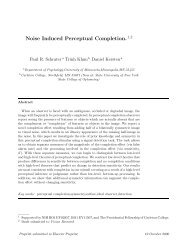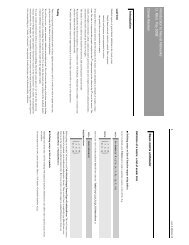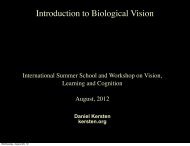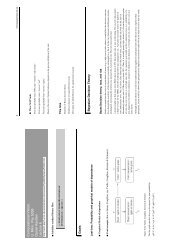MIDTERM EXAM
MIDTERM EXAM
MIDTERM EXAM
You also want an ePaper? Increase the reach of your titles
YUMPU automatically turns print PDFs into web optimized ePapers that Google loves.
PSY 5065 - fMRI: Hands-on Training<br />
<strong>MIDTERM</strong> <strong>EXAM</strong><br />
Date assigned: March 6, 2009<br />
Date due: March 13, 2009<br />
Each problem: 5 points<br />
Total exam: 15% of course grade<br />
Problem 1: Basic NMR<br />
A) What magnetically active nucleus generates the signal we detect to make a typical<br />
MR image? (1 point)<br />
B) The gyromagnetic ratio of carbon-13 is 10.7 MHz/T. What is the resonant frequency<br />
of 13 C at 3 Tesla? How does this compare to the resonant frequency of 1 H at 3 Tesla?<br />
(1 point)<br />
C) A spin isochromat is a collection of a large number of spins in an exactly uniform<br />
magnetic field environment. This is a useful construct because the large number of<br />
spins lets us consider the bulk magnetization of the isochromat, which behaves like a<br />
classical magnetic dipole, instead of individually considering spin-1/2 particles with<br />
quantized states. At equilibrium, in an external magnetic field oriented along the positive<br />
z- axis, what is the orientation of the net magnetic moment of a spin isochromat?<br />
(1/2 point)<br />
After application of a (perfect) inversion pulse, what is the orientation of the net<br />
magnetic moment of the isochromat? (1/2 point)<br />
D) After application of a 90 y degree excitation pulse (rotating M around the y-axis),<br />
what is the orientation of the net magnetic moment, M? (1/3 point )<br />
What is the relative magnitude of the longitudinal magnetization, M ||, if M is 10 units?<br />
(1/3 point)<br />
What is the relative magnitude of the transverse magnetization, M ⊥ ?<br />
(1/3 point)<br />
E) After application of a 30 degree excitation pulse, which is greater: M || or M ⊥ ? (1<br />
point)
PSY 5065 - fMRI: Hands-on Training<br />
Problem 2: Relaxation<br />
A) Label, on the drawing below, the T 2 and T 2 * envelopes describing the magnitude of<br />
the net transverse magnetization generated by a collection of spin isochromats in an<br />
inhomogeneous magnetic field environment during a spin echo experiment. (1 point)<br />
Excitation pulse<br />
Refocusing<br />
Echo<br />
Read-out<br />
M T<br />
S<br />
B) In the inversion-recovery experiment illustrated below, what would be the appropriate<br />
time to apply an excitation pulse if you wanted to null the signal from the gray matter?<br />
(1 point)<br />
White matter<br />
Gray matter<br />
CSF
PSY 5065 - fMRI: Hands-on Training<br />
C) In the data shown above, which has the longest T 1 : gray matter, white matter or<br />
CSF? (1 point)<br />
D) In the acquisition described in (B) (TI set to null gray matter), what would be the<br />
relative image intensities of white matter and CSF in a magnitude image? (1 point)<br />
E) In any experiment, if the repetition time is very short, should the flip angle of the<br />
repeated RF pulse be large or small? (1 point)<br />
Problem 3: Pulse sequences<br />
A) If a 45 degree RF pulse with 2 kHz bandwidth is applied in conjunction with a linear<br />
magnetic field gradient on the x-axis with a strength of 11.7 mT/m (500 Hz/mm), what is<br />
the resulting slice thickness? (1/2 point).<br />
What is the orientation of the slice (1/2 point).<br />
B) What is the read-out direction in the image below (up/down or front back)? Describe<br />
the clues you used to figure that out. (1 point)
PSY 5065 - fMRI: Hands-on Training<br />
B) Label the slice-select, read-out, and phase-encode gradient axes for the two pulse<br />
sequences illustrated below. Describe each pulse sequence as FLASH or EPI, Spin<br />
Echo or Gradient Echo. (2 points total - 1/6 each for gradient labels, 1/4 for each FLASH<br />
vs. EPI, and 1/4 for each SE vs. GE)<br />
Pulse sequence 3.B.1: _________________________________________<br />
N = 4<br />
RF<br />
G ______<br />
G ______<br />
G ______<br />
DAC<br />
Pulse sequence 3.B.2: _________________________________________<br />
RF<br />
G ______<br />
G ______<br />
G ______<br />
DAC
PSY 5065 - fMRI: Hands-on Training<br />
C) Draw on the grid provided below the k-space trajectory for the pulse sequence in<br />
3.B.2. Make sure to label the phase-encode direction. (It might help to number the<br />
gradients to match k-space excursions; no need to be precise once you get to the readout<br />
lines.) (1 point)<br />
Sequence 3.B.2
PSY 5065 - fMRI: Hands-on Training<br />
Extra Credit (1 point). For the EPI images shown below, indicate which was acquired<br />
with a spin echo pulse sequence, and which was acquired with a gradient echo pulse<br />
sequence. Assume both had the same echo time during the acquisition.










